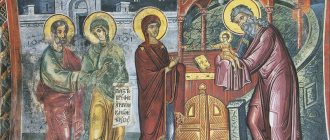Human memory is designed in such a way that it stores evil deeds well. We know very well the biographies of Hitler, Stalin, Caligula and other bloody tyrants. But few people can remember the real name of the one who went down in history under the nickname “Good Samaritan.” What this expression means became known thanks to the Bible.
Parable of the Good Samaritan
Among the edifying stories told by Jesus Christ to the common people, the tale of the merciful inhabitant of the Samaria region
.
One of the teachers of the law (i.e., the interpreter of Jewish law) decided to inquire about ways to gain eternal life. Jesus answered that it is enough to live in love with others. The answer seemed too vague to the questioner, and the prophet decided to illustrate it with a real-life incident:
- The hero of the parable is a Jew who covered the road to Jericho on foot;
- But on the way he came across bandits who stripped him to the skin and left him to die in the middle of the road;
- The unfortunate man lay on a busy road for a long time, but no one helped him. Both the ordinary decent Jew and the priest did not find it in themselves to pity him;
- But help arrived from one of the Samaritans
(the Jews considered them long-time enemies). He did not spare his last money to help the dying man.
In this way, Jesus demonstrated to the lawyer the need to help anyone in trouble. And it doesn’t matter where he comes from, what religion or nationality he is.
What did the experiment show?
A completely unambiguous conclusion follows from the experiment: people who are busy and not busy with religious thoughts are equally inclined to help those in trouble. But haste has a significant impact on the desire to provide assistance to victims.
The importance of norms of helping, reinforced by the parable of the Good Samaritan, would seem to have a stronger influence on the behavior of the subjects. But there was no statistically significant effect, to the surprise of the experimenters themselves. Does this mean that the constant rush that is common in modern society has led to a decline in ethical standards? And people, knowing that someone needs help, deliberately ignore him?
Experimenters believe that no, since a person in a hurry experiences some slowdown in their interpretation of what they see or their empathic reactions to the situation. This is the so-called “narrowing of the cognitive map,” described by W. Tolman. That is, the subjects saw the victim, but did not realize in time that she needed help, and did not perceive the situation they saw as a case where they needed to make an ethical decision.
Other subjects managed to realize this and found themselves faced with a difficult choice: to help a suddenly encountered person or to fulfill their duty to the experimenter, who was already waiting in another building. This is a complex internal conflict, which, however, cannot be called callousness. The experimenters noted that some subjects were anxious because they had to make such a decision.
Who are the Samaritans?
Samaritans today
They are a small people of no more than a thousand people. They live in Israel in peace and tranquility with the titular nation of Jews.
But two thousand years ago, these two peoples had many reasons for dislike for each other:
- The ethnic group received its name from the city of Samaria, which was the last capital of the Kingdom of Israel. They were forcibly removed there by the Assyrians;
- Once on Jewish soil, the people adopted local customs, but did not forget their own;
- Problems with assimilation caused conflicts with Jews, sometimes escalating into open clashes;
- By 539 BC. e. the peoples on both sides of Canaan finally separated;
- Alexander the Great, after conquering the Middle East, decided to take advantage of local conflicts and helped national minorities in the fight for their rights. So, with the participation of the Macedonian administration, the Samaritan temple was built;
- The Romans continued their policy of division and rule. They gave the Jews' opponents wide autonomy and forced them to embrace paganism;
- In subsequent centuries, the population of the people dropped noticeably due to Islamization.
[edit] Culture and religion
The languages of the Samaritans are Hebrew (a Samaritan script based on the original Hebrew alphabet, close to Phoenician). The Samaritans of Nablus also speak Arabic.
Religion is a type (sect) of Judaism. Sacred books - the Torah and the Book of Joshua (in versions that differ from the canonical versions - especially the latter).
The Samaritans are buried in the cemetery on Mount Gerizim. For seven days, the relatives and friends of the deceased read the Torah, and on the eighth, men must shave their beards[2].
Number of people: about 720 people in 2008, 745 people in 2011[3].
Good Samaritan Law
Under this conventional name in the United States, a set of regulatory and legal acts related to assistance to victims before the arrival of rescuers is known.
Almost every state has its own set of laws, but they are all based on common sense principles
:
- A person is obliged to help the victim only if they are connected by family ties, he is the attending physician or the culprit of the distress. In all other cases, the law leaves the right of salvation to the discretion of each citizen;
- If a passerby decides to voluntarily approach the victim, then he has no right to leave the scene of the incident until the ambulance arrives. The only exception: danger to the life of the assistant himself;
- Successful saving of someone else's life is not subject to payment, even if the actions were performed by a qualified specialist;
- All other things being equal, the Samaritan is not responsible for possible loss of health as a result of disservice;
- The victim's opinion matters. If he has clearly expressed his desire not to accept help, then violation of his will will be punished to the fullest extent of the law.
Experiment results
It turned out that those subjects who were in a hurry provided less help in most cases than those who were not in a hurry. The topic of the speech that the subject had to give did not have a significant effect on the provision of assistance.
Quantitative data looks like this:
- Of the 40 subjects, 16 (40%) offered the victim any direct or indirect help, 24 (60%) did not.
- At low levels of haste, 63% offered help; at an average level of haste - 45%; at a high level of haste - 10%.
- Of the subjects who had to give a speech regarding the provision of help, 53% offered help; of the subjects who had to give a speech concerning the formal topic of the experiment - 29%.
Thus, the second hypothesis was confirmed: a person in a hurry is less inclined to provide assistance. Religious thoughts did not have a significant effect on behavior. Those students who were going to talk about the parable of the Good Samaritan were not much more likely to help than those who were going to talk about professions.
The third hypothesis, based on types of religiosity, was also not supported: the correlations between ratings of religiosity and the study’s dependent variables were not statistically significant.
Cultural perception
The plot is one of the most popular in world art, especially medieval. Almost every great artist dedicated one of his paintings to him:
- Rembrandt;
- Vincent Van Gogh;
- Aime Morot;
- Domenico Fetti;
- Johann Karl Loth;
- George Frederick Watts;
- Giacomo Conti;
- Jan Wijnants.
Modern culture also has many references to the legendary parable of Christ:
- English composer Benjamin Britten wrote a work of the same name for the centenary of the Red Cross;
- In 2003, the Austrian mint issued a series of banknotes, the reverse of which depicts scenes from the Bible (including helping one's neighbor);
- The original interpretation is contained in the sixth episode of the fourth season of the American series Agents of S.H.I.E.L.D.;
- The Hellboy comic book series also draws on well-known Christian themes.
Rembrandt painting
Rembrandt van Rijn, one of the world's greatest painters, could not ignore the famous biblical story. In 1633, he showed the world a painting about man’s love for his neighbor:
- The foreground is entirely occupied by a horse, which the servants hold by the bridle;
- Another servant helps the dying man up the stairs into the room;
- At the entrance stands a wealthy man in whom one can recognize virtue. He gives the owner of the house dinars as payment for caring for the victim;
- At the left edge of the picture you can see a young man wearing a feathered hat;
- The unfortunate man looks in his direction. The expression on his face suggests that he barely understands where he is. According to the popular reading, the Jew believes that he fell into the clutches of the leader of the robbers who tore him to pieces;
- According to critics, the image of a Jew most accurately conveys the situation of a person worried about his life. Neither before nor after have artists been able to depict the expression of helplessness on a face like this;
- At the right end of the canvas, an indifferent maid takes water from a well.
A few years later, Rembrandt painted another version of the painting.
Experimental procedure
All subjects who came to participate in the experiment were given an explanation of the need for the study to read by the assistant, and then given the task: record a 3-5 minute speech on a tape recorder, which must be delivered based on the proposed text. The first text was about a future career, and the second was the parable of the Good Samaritan. The subject had to say what he himself thought about the proposed text, but not use the recording.
The assistant left the student alone with the text for a few minutes, and then returned and explained that, since there was little space in this building, he would need to go to another building to write, and showed the way. Variable 2 was then entered: rush. The assistant, looking at his watch, told the subject that he had better hurry up, since they were already waiting for him and he was late.
When the subject passed along the road, the “victim” sat at the door of the house, motionless, in a crouched position; he coughed and groaned a couple of times. If the subject stopped and asked what happened and if help was needed, then the “victim” explained that he was suffering from a lung disease, everything was fine, he had pills and had just taken them. Having thanked the student, he refused help. If the subject insisted on helping, then the “victim” allowed him to be taken into the house and thanked him.
The assistance was assessed by the “victim” himself on a scale from 0 to 5:
0 - the subject did not notice at all that the “victim” may need help;
1 - the subject noticed the victim and realized that help was needed, but did not offer it;
2 - noticed, but did not stop and helped in an indirect way (for example, told the experimenters about the person in need of help);
3 - stopped and asked if help was needed;
4 - stopped and helped me into the house.
5 - Refused to leave the victim (after 3-5 minutes) and insisted on taking him somewhere else, such as getting coffee or going to the hospital.
After the incident, the student went to the second building, where he was given time to prepare and record the speech without witnesses. He then received a questionnaire about personal and social ethics, which included 3 main questions: a) “When was the last time you saw someone who might need help?”, b) “When was the last time you stopped to help someone?” someone in need?”, c) “Have you ever had to help people in trouble? If yes, please tell us about it briefly.” This data was collected to determine whether the subjects actually failed to notice the victim and whether they perceived the incident as a situation where help was required.
Then the subject was told about the true meaning of the experiment, explaining the reasons for the deception and its necessity, and discussed the subject’s reaction to the “victim” and to the experiment in general. The authors claim that all subjects understood the need for the experiment and none of them were outraged. This was probably done to maintain the ethics of the experiment.
The expression "good Samaritan"
The phrase has become a catchphrase and is used to denote someone who is ready to sacrifice the very last for the sake of a complete stranger.
. It is this meaning that is reflected in the names of some hospitals, hospitals and charities.
Often the expression is used figuratively, in relation to those who flaunt their “kindness”.
Theological science is devoid of such one-dimensional interpretations of the legendary parable:
- The Greek philosopher Origen interprets it as the salvation of Adam by Jesus, which speaks of the inevitability of the Second Coming. The passing priest represents the heartless law that protects those in power;
- Augustine will offer an even more symbolic interpretation: Jericho personifies eternal life, those who passed by - the Old Testament, the owner of the house (where the victim was sheltered) - the Apostle Paul. According to modern philosophers, such an interpretation is considered a “hodgepodge” that has nothing to do with the original message;
- One of the leading figures of the Reformation, John Calvin, believed that history suggests an innate obligation between all people on earth.
The Bible is the foundation of Western civilization. The culture of any country that has adopted Christianity contains numerous references to Middle Eastern folklore. So, to denote selfless philanthropy they say: “good Samaritan.” This expression is equally well understood both in New York and in Moscow.








